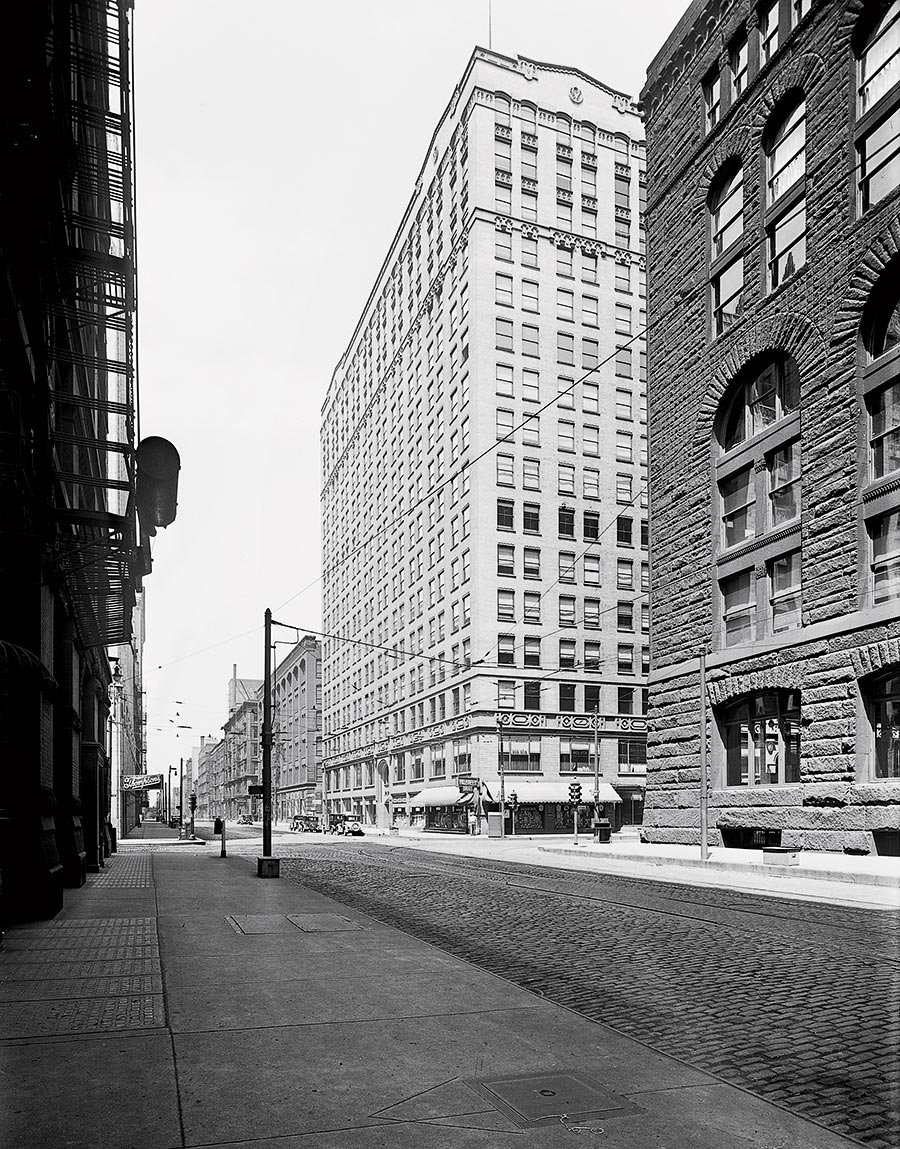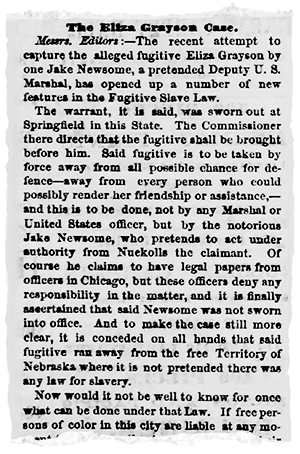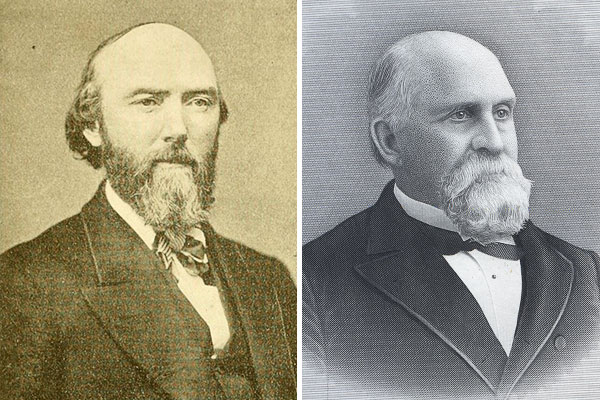
In November 1860, Chicago wasn’t yet known as a theater town, but a remarkable piece of stagecraft — front-page news in its day but now all but forgotten — played out on its streets: A crowd surrounded a woman and, poof, she vanished.
The woman in question, 20-year-old Eliza Grayson, had good reason to want to disappear: She was a fugitive from slavery. Two years earlier, she and her sister had escaped their slaveholder, aided by a free black man from Iowa. Grayson then made a harrowing 500-mile journey from Nebraska, likely taking refuge in safe houses on the Underground Railroad. She’d been among the first enslaved people to arrive in Nebraska, which had not decided whether to allow slavery, when she’d been brought there from Virginia by a man named Stephen Nuckolls. He was now after her.
Though Illinois was a free state, it was hardly a haven for black people, who represented less than 1 percent of Chicago’s population of around 112,000. Just over two years before the Emancipation Proclamation, the law of the land that Abraham Lincoln called home barred any out-of-state black person from staying in Illinois for more than 10 days — and prohibited all blacks from voting or even gathering in groups of three or more.

Grayson had found work as a servant in a Clark Street brothel. She was, the Chicago Daily Tribune would later report, “a stout and sharp girl, and her services as a domestic much prized.” Working in the demimonde of a rowdy city would seem the ideal way to escape being seen, but it turned out that she wasn’t invisible to people who knew money could be made capturing fugitive slaves. “In 1859 and 1860, negro catchers were particularly active in this locality,” Weston Goodspeed wrote in his 1909 book History of Cook County, Illinois. He went on to quote a newspaper article from Grayson’s time whose language evokes the grotesque realities of the era: “The goodly number of fine fat chattels most provokingly free about this vicinity, and their market value down the river, are two circumstances that are constantly inviting the scant moral sense of the ‘nigger stealers.’ ”
Unthinkingly, Grayson “told her story of escape and her former condition to one of the unfortunate white females of the house,” the Tribune reported. That woman and some cohorts pressed Grayson for more information. “By dint of questioning and threats, they ascertained her master’s name and residence,” the Chicago Daily Journal reported. “They at once opened a correspondence with him, informing him of her whereabouts, and offering to deliver her up for a sum.” For good measure, they proposed to “knock her down, render her senseless, and then put her in the box of a pedlar’s wagon, and carry her out of the State in this manner.”
Nuckolls opted instead to come to Chicago in person to capture Grayson, whom he valued at $1,200. He arrived in the city bearing an arrest warrant, obtained in Springfield, but the federal commissioner in Chicago, Philip A. Hoyne, had no deputies who were willing to serve it. Bound by the Fugitive Slave Act of 1850, which required officials in free states to cooperate in the forcible return of fugitives to their slaveholders, Hoyne deputized a man named Jake Newsome, whom the Tribune would describe as an unprincipled kidnapper for hire.

On the evening of November 12, Newsome and Nuckolls seized Grayson. Screaming as the two men dragged her along Clark Street, she attracted the attention of onlookers both black and white. Some accounts of what happened next describe a prominent abolitionist, Chancellor Jenks, arriving on the scene to try to wrest Grayson from her captors’ hands. These accounts, published after Jenks died in 1903, cast him as a quick-thinking hero who happened, improbably, to stumble across the kidnapping in progress. It seems more likely that Jenks, an attorney and real estate investor, got word of the abduction from a fellow abolitionist, George Anderson, one of the deputy sheriffs who had refused to serve the arrest warrant.
Whatever the exact circumstances, Nuckolls and Grayson were both charged with disorderly conduct and locked up at the Armory police station on the southwest corner of Adams and Franklin Streets, where the Willis Tower now stands. Contemporary news accounts suggest that the charge was manufactured by Anderson — possibly in collusion with Jenks and a like-minded justice of the peace named Calvin De Wolf — so that Grayson could be held in safety while the abolitionists set about summoning a crowd to the Armory.
When Anderson went to transfer Grayson from the Armory lockup to a nearby jail, the Journal reported, “he had hardly got out of the door with his charge before she was wrenched from his grasp.” The report goes on to remark that Anderson “did not make a very sturdy resistance, and when the crowd dispersed, Eliza Grayson had disappeared. … With the rapidity of lightning, she was hurried down Adams Street by the agents of [the Underground Railroad] and removed to a place of safety.” Most accounts say she was put on a boat to Canada.
News of Grayson’s escape made its way to President James Buchanan. He was said to be furious and wrote an angry letter to the U.S. attorney in Chicago, urging severe penalties for those involved. Buchanan was a Northerner who opposed slavery but believed that the Constitution permitted it. In his inaugural address, he’d endorsed the Supreme Court’s Dred Scott decision, which ruled that the descendants of enslaved people did not have citizenship rights. In the end, with Buchanan’s term nearing its end and Lincoln soon to take his place, nothing came of Buchanan’s tirade.
What happened to Nuckolls? One account, in a book called Pioneer Settlers of Grayson County, Virginia — probably exaggerated to arouse sympathy for the slave owner — reported that police officers came into his cell planning to hang him. “He placed himself in one corner of the room, drew his revolver and said to them, ‘the first man that opens that door, I will shoot him down.’ They did not go in, but he had to pay $22,000 to get out of the jail.” Other observers claimed that the police had to disguise Nuckolls as one of them in order to whisk him out past the angry crowd. Whatever his immediate fate, Nuckolls soon returned to Nebraska. Today there’s a county named for him, and in Nebraska City there’s a park called Nuckolls Square on land he donated.
As for Eliza Grayson, little is known of her life after her escape. She appears to have passed out of living memory with no monument to remember her by.



